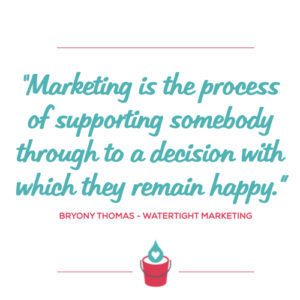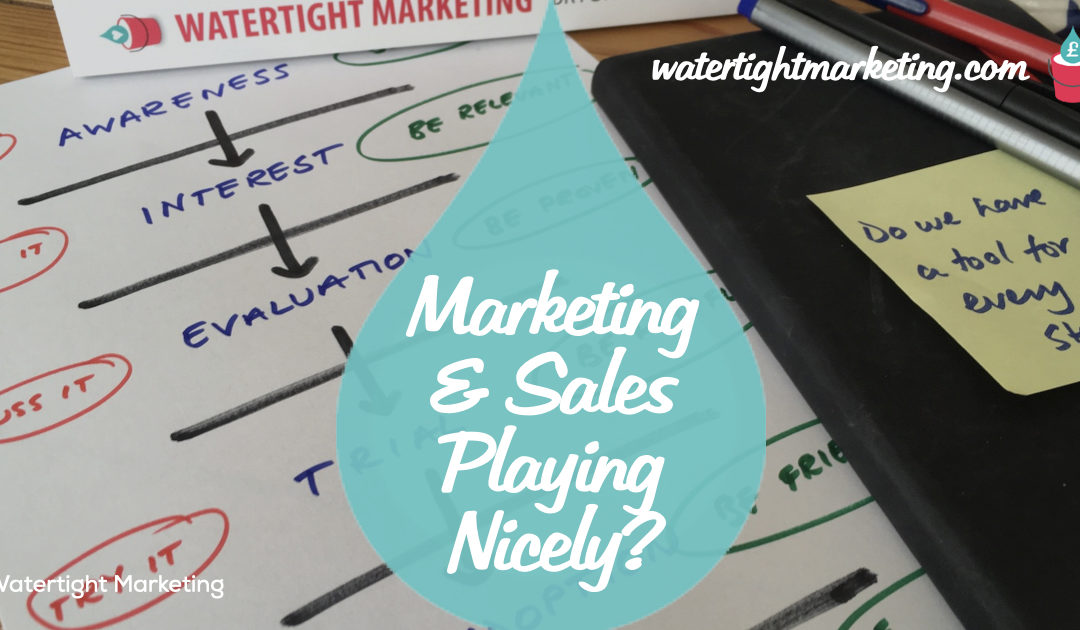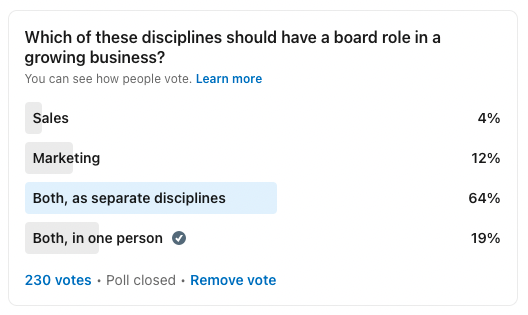Prefer to listen than to read?
This post is also available over on our PodBlog
Reading Time: 8 Minutes
Getting marketing, sales (and service) to work together effectively is key to ensuring that customers have a consistent experience in their path to buying from you. To achieve this a business needs what we call ‘journey brain’ – that is, the ability to see and support someone through their whole journey from initial awareness to loyalty and advocacy. One of the questions that comes up (time and time again) related to this is… what’s sales and what’s marketing, and how do we get them to work together? So, let’s explore that… ~ Bryony Thomas, Author | Watertight Marketing
I have a bit of a long-standing debate in my mind, and occasionally with others, as to whether the word ‘marketing’ is a problem for us. This is because my definition of marketing seems to be be deeper and broader than a lot of the rest of the world. Including within our ideal clients!
Yeah, but that’s not marketing…
Indeed, I had a chat with the sales director within one of our marketing transformation clients just this week where he fessed up that he’d been pretty cynical when his MD starting spouting my Buckets, Funnels & Filters, and Taps metaphor at him. He no doubt rolled his eyes when my cat routine was re-told.
On being gifted a copy of the book, he approached it with caution to find himself nodding vigorously at almost every page. But, here’s the thing… lots of what I call marketing, he calls sales. And, further than that, lots of what I call marketing their team see as customer service.
Now, my mission is not to rebrand marketing, nor to update the prevalent business lexicon that has it defined as lead generation and colouring in. My mission is to stop businesses wasting time, money and energy on activities that won’t work. It’s to enable them to achieve world-class customer journeys resulting in a healthy business, in the long term.
See: The unseen activities that makes the lead generation and colouring in work
 My definition of marketing is: the process of supporting somebody through to a decision with which they remain happy.
My definition of marketing is: the process of supporting somebody through to a decision with which they remain happy.
Academically speaking (and as it was taught to me in my CIM Diploma and MBA), sales is a marketing technique to be employed within this process – just like PR, content, advertising, etc. In the real world, they’re seen as two separate disciplines that have to work together. In this post, I’m going to draw out a few key areas of thought, then post on each one separately.
The role of marketing, and the role of sales
In the most wasteful of definitions marketing is seen as being responsible for lead generating (or Taps), sales for converting those leads into sales (Funnels & Filters), and service as responsible for delivering what’s been bought (Bucket). It’s my preference to see the customer journey end to end, and then to coordinate those with the right skills to support each stage. And, in my experience people from marketing, sales and service have an essential contribution to make at every one.
The strategic and tactical skills of each
I will explore these using two of the core Watertight Marketing frameworks. The first takes a strategic perspective, using the Four Flow Foundations (See Chapter 2 and 11 of the second edition). These are the four foundations on which stable and healthy business growth can be achieved, and each require input from everyone in a business. The second uses a tactical lens, of the Thirteen Touchpoint Leaks™ (Chapter 2, and Part Three), where the tools and techniques a marketer can bring to the table are mapped to a customer journey – but will only work when enthusiastically used by people in sales and service.
The time horizons of marketing and of sales
This is where the differences between the day-to-day activity of someone with sales or marketing in their job title really start to become evident. The time horizon they work to is usually different. A marketer will be looking at least 12 months out, whereas a salesperson will be focused (and indeed paid) by this quarter and this month’s sales goals. It might be more useful to consider the baton passing from one to the other through time, rather than through stages in a customer journey.
Measuring and rewarding sales and marketing
Closely linked to the point above, how you measure and reward your sales and marketing people will impact how well they perform. Performance related pay is the norm for a sales role, but not for marketing. It’s precisely because of the long timelines and the difficulty in drawing a straight line between marketing activity and sales results that marketing is often seen (particularly by finance) as an overhead rather than a revenue generator. I’m looking forward to writing about how to measure and reward these, and the direct impact that can have on results.
Which should you recruit first, sales or marketing?
In a growing business, it’s very often the case that you need to choose between either recruiting someone with sales skills, or someone with marketing skills. They rarely come packaged in one person. So, which comes first? Here I might be accused of betraying my peers – but in almost all cases I would start with a salesperson. I would do that in tandem with some strategic marketing counsel from a good consultant, and with some investment across the team in understanding where marketing adds value (getting everyone to read Watertight Marketing is not a bad place to start), and probably some retained freelance or agency support. To answer this question, I’m going to post about stages of sales & marketing maturity and when to in-source which skills.
Collaboration, and the importance of a common language
What makes or breaks the achievement of a seamless customer journey and predictably delivers a healthy bottom line, (in the long term), is getting everyone in your business aligned and playing their part in that process. It is precisely the reason I wrote the book.
Watertight Marketing is definitely a useful checklist of what to do in interacting with the outside world… but, its real power is as an internal communication tool. When you all speak Watertight, you use the same words to mean the same things, know how and where you can add value, all understand what to do next, and why. When you build systems and processes around the Watertight methodology, it all flows better. That’s the point!
Sales and marketing on the Board
I recently asked this question over on LinkedIn. The poll results indicated that 96% of people think marketing should have a seat at the Boardroom table, and 87% think sales should. With this being the case, in a smaller business, this is likely to be in the form of one person.
And, so the question becomes which is the lead discipline? It’s not going to surprise you to hear that I think this is marketing… but a marketing person with a very keen sense of sales. However, by dint of sales usually having been recruited first (which I agree with) they’ve often bagged the seat.
If there is no-one on the Board that considers themselves a marketer through and through, I would advise retaining a strategic sounding board or NED with these skills AND investing in marketing training for the whole board (which is what we do, by the way!).
See: The skills of a marketing director and what they bring to the boardroom
Making marketing, sales, (and service!) work well together
the question often comes up as to how to achieve sales and marketing alignment, and observations are made about disharmony and dysfunctional interplay between these teams. What a growing business needs is a recipe for making this all work effectively. This starts by also extending to service. Obviously there are also interfaces with tech, HR, finance, etc. But, Marketing, Sales and Service, between them, are responsible for the customer journey. I’m looking forward to penning a post with a bit of a sequenced checklist for making this all work (which is precisely what we do in a marketing transformation programme, by the way).
What other questions do you have?
So, this is my list of things to muse and post about in coming weeks. Is there anything else on this topic you’d particularly like me to put my mind to? Do comment below to let me know what to put on the list.
By Bryony Thomas, Author – Watertight Marketing

Bryony Thomas
Author & Founder, Watertight Marketing
Bryony Thomas is the creator of the multi-award winning Watertight Marketing methodology, captured in her best-selling book of the same name. She is one of the UK's foremost marketing thinkers, featured by the likes of Forbes, The Guardian, Business Insider and many more, and in-demand speaker for business conferences, in-house sales days and high-level Board strategy days.




Marketing that misleads is a problem.
Sales that get returned are a problem.
Deliveries that upset people are a problem.
When each has its own team and manager, the potential for each to cause problems for the other multiplies.
Journey overview is essential within this time frame.
Add repeat custom to the overview and managing the entire process from before-enquiry to beyond-fulfilment is THE profit centre.
That’s a really useful and insightful contribution Dave, thanks. Everything we do should make the jobs of others in our team and those we interact with easier, not harder… a great guiding principle.
in my experience, it is about how sales and marketing are measured and rewarded. This however is often rooted in how sales and marketing departments are set up as cost centres with seperate budgets. So conflict arises in defending those budgets. This comes back to your point about having a ‘journey brain’. This has to extend to the finance department/director as it often ‘that’s how the accounts are set up and managed’ is the justification for having seperate budgets!